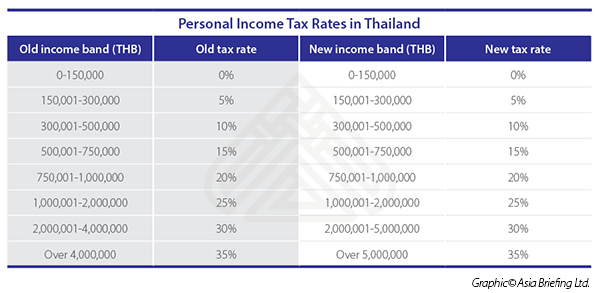To view this article on our website ASEAN Briefing, please click here.
To download for free our Guide “An Introduction to Doing Business in ASEAN 2017“, please click here.
Thailand’s updated personal income tax (PIT) structure officially came into effect on January 1, 2017, with the aim to ease tax burdens and boost disposable income. The revision, Revenue Code Amendment Act (No 44) BE 2560, was gazetted on January 27, officially instituting the changes. The new rates apply for all income collected as of January 1 for filing in 2018. The revised income tax scheme was initially approved by the Thai Royal Cabinet on April 19, 2016.
The new structure revises the income tax bands subject to 30 percent and 35 percent tax, and increases deductibles, and doubles allowances. The lower income tax bands and their respective rates remain unchanged. The revision also raises the minimum thresholds for mandatory tax filing.
Updated income tax bands
The PIT update changes the bands subject to 30 percent tax rate from THB 2,000,001-4,000,000 to THB 2,000,001-5,000,000, and the 35 percent tax rate from over THB 4,000,000 to over THB 5,000,000. The changes result in a five percent reduction for those earning between THB 4,000,001 and THB 5,000,000. Thailand’s complete PIT brackets are as follows:
Deductible expenses and tax allowances
The deductible amount for general expenses has been raised from 40 percent of taxable income with a maximum of THB 60,000 to 50 percent of taxable income with a THB 100,000 limit. Tax allowances have been doubled across the board. Personal allowances have been increased from THB 30,000 to THB 60,000, or a combined THB 120,000 for taxpayers with an earning spouse. Spousal allowances have also been raised from THB 30,000 to THB 60,000. Child allowances have increased from THB 15,000 per child with an eligible limit of three children to THB 30,000 per child with no limit, except for adopted children, where there is a three child cap. However, the additional THB 2,000 educational support allowance for children has been eliminated with the update.
Tax reporting threshold
The revised PIT law raises the threshold for tax filing from THB 50,000 to THB 100,000 for a single taxpayer earning only employment-derived income, or THB 100,000 to THB 2000,000 if filing jointly with a spouse. For those with other sources of income, the threshold has been raised from THB 30,000 to THB 60,000, or THB 60,000 to THB 120,000 in a joint submission. Even if there is no tax that ultimately needs to be paid, those meeting the threshold have to file with tax authorities, while low-earners below the threshold do not have to file.
Observations
The updated PIT rates ease the tax burden for a relatively small portion of the population, giving them more disposable income and leading, it is hoped, to increased domestic spending. The new deductions and allowances affect a much broader swathe of the Thai population, many of whom had argued that deductions were too low and out of sync with actual living expenses. However, the changes are fairly modest overall, and with ongoing competition and tax harmonization between ASEAN states, further reductions in PIT rates could be on the table going forward.
- Online article – ASEAN Briefing
- Download our Guide “An Introduction to Doing Business in ASEAN 2017”

